In today's cutthroat content marketing arena, having a workflow that can swiftly fetch Google search data and execute tasks intelligently is not just nice—it's essential! Enter our dynamic duo:
- Dify.ai: A low-code platform that lets you whip up AI applications faster than you can say "automation."
- Deep SerpApi: A turbo-charged Google SERP data extractor that delivers structured search data at lightning speed and a fraction of the cost.
By combining these two powerhouses, you're not just saving development time; you're also unlocking rapid-response SEO capabilities without breaking the bank.
What is Dify?
Think of Dify as the Swiss Army knife for AI application development. It's open-source, versatile, and ready to tackle your AI needs with flair. Here's what makes it stand out:
1️⃣ Rapid App Development: No need to dive into complex code. With drag-and-drop functionality, building AI apps is as easy as pie.
2️⃣ Flexible Workflow Management: Mix and match nodes, pass variables, and integrate APIs to create workflows that fit your unique needs.
3️⃣ Seamless Third-Party Integration: Whether it's external APIs or data type conversions, Dify handles it all with grace.
It's like having a supercharged toolkit that turns your AI ideas into reality—no cape required.
What is Deep SerpApi?
Deep SerpApi is a Google SERP data scraping API launched by the Scrapeless team. It can extract structured search results of Google pages, covering more than 20 types of Google scenarios. The following are the 8 most popular ones:
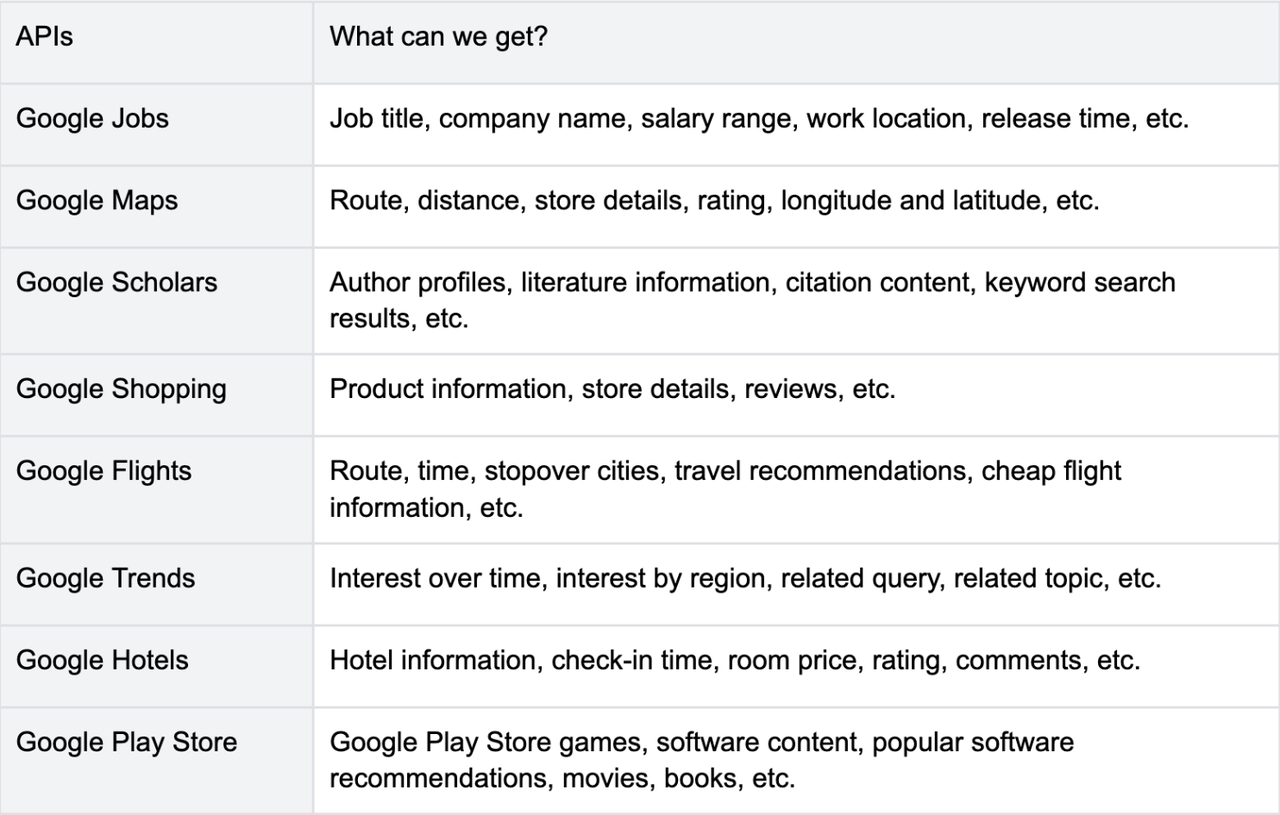
You can figure out more in Scrapeless Dashboard
Join our developer program and get 50K free calls per month!
Its main advantages include:
- Super fast response: average response time of 1~2 seconds to meet real-time call requirements
- Extremely low price: only $0.1/1K requests, greatly reducing the cost of obtaining data
- All-region support: local search results can be obtained in any country or city
- Multi-language support: compatible with mainstream languages such as Python, Node.js, Golang, etc.
- LLM-oriented optimized output: provide real-time, accurate, and objective contextual information for AI models through RAG and MCP, and customize return fields and formats
Benefits to Integrate Scrapeless into Dify
Benefits to Integrate Scrapeless into Dify platform include the following obvious benefits:
💨 Simplify the development process: With the help of Dify low-code features, you can quickly develop applications without writing complex code from scratch.
⏰ Real-time data support: Use the real-time search data provided by Deep SerpApi to provide a reliable basis for subsequent content creation.
💰 Reduce maintenance costs: No need to develop or maintain search engine crawler tools by yourself, which greatly saves development and later maintenance costs.
💡 Flexible expansion: The entire process can be adjusted and expanded according to actual needs, making it convenient to integrate more SEO or content optimization functions in the future.
How to Integrate Dify.ai & Deep SerpApi?
By integrating Dify with Deep SerpApi, we can try to build a set of intelligent SEO title generation tools, which can crawl Google search results in real time and use the large language model (LLM) for semantic understanding and content creation, so as to generate more attractive and accurate titles.
Continue reading and follow my steps to complete it!

1. Create an app via "Create from Blank".
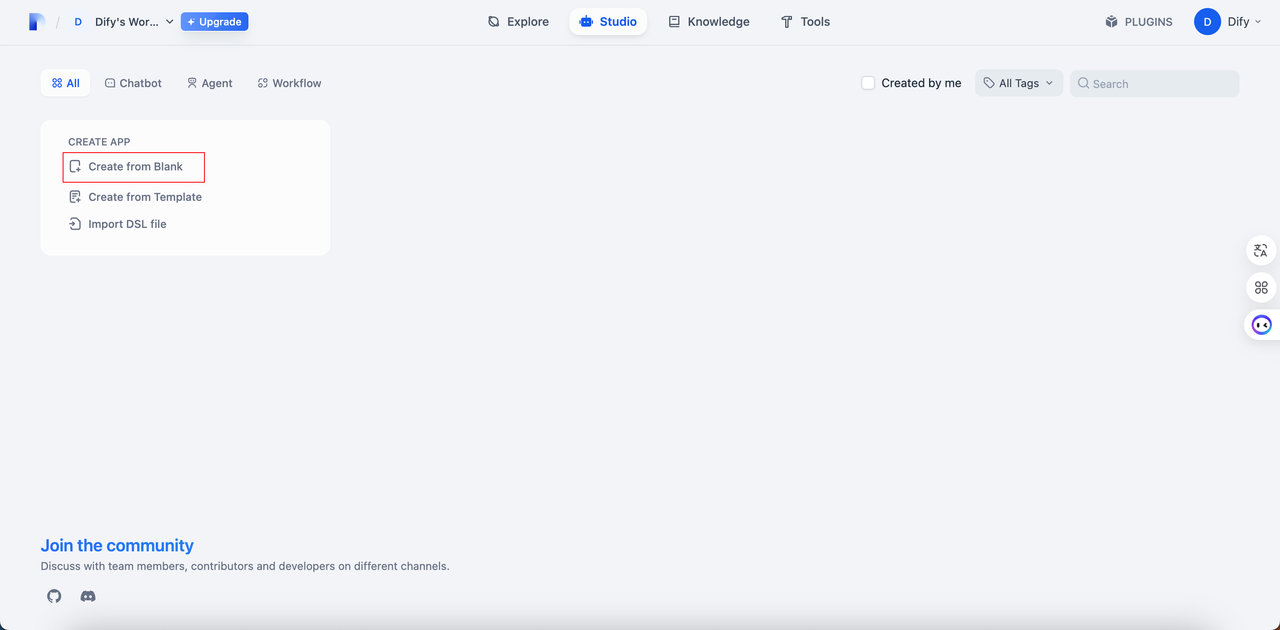
Select workflow and enter the name and description.
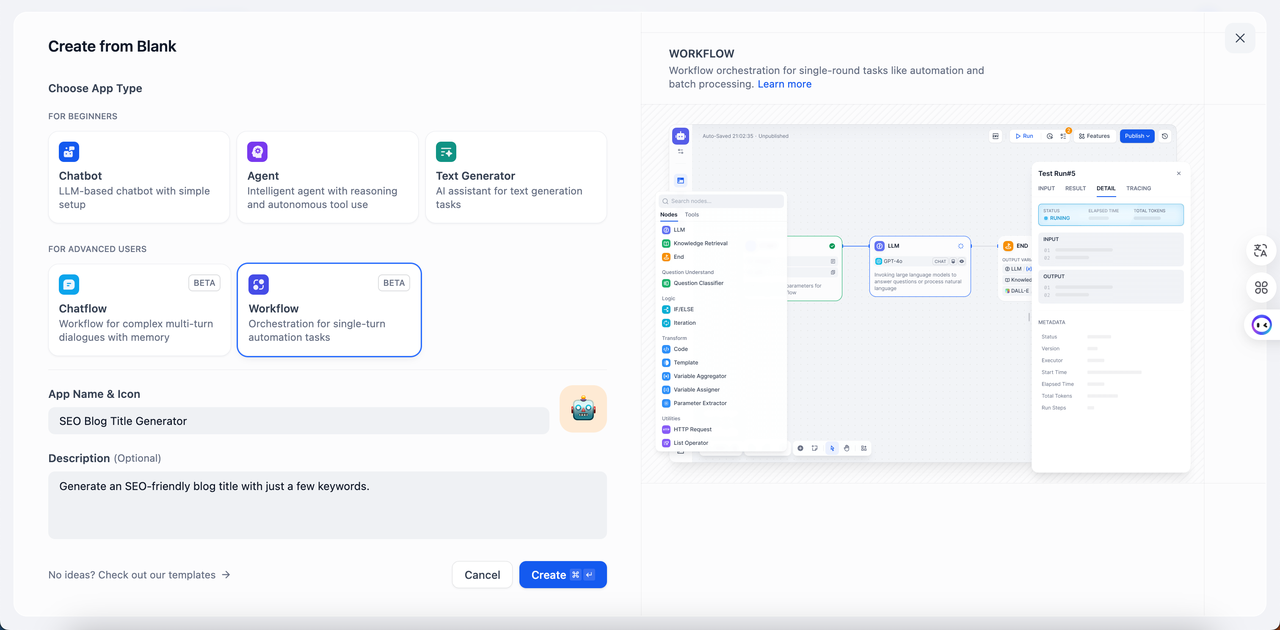
2. Add input nodes and fields.

3. Choose the Deep SerpApi node to help access Google.

Set up search input.

4. Adapt data types
Since the output format of Deep SerpApi is JSON, we need to add a Code node to adapt the type:
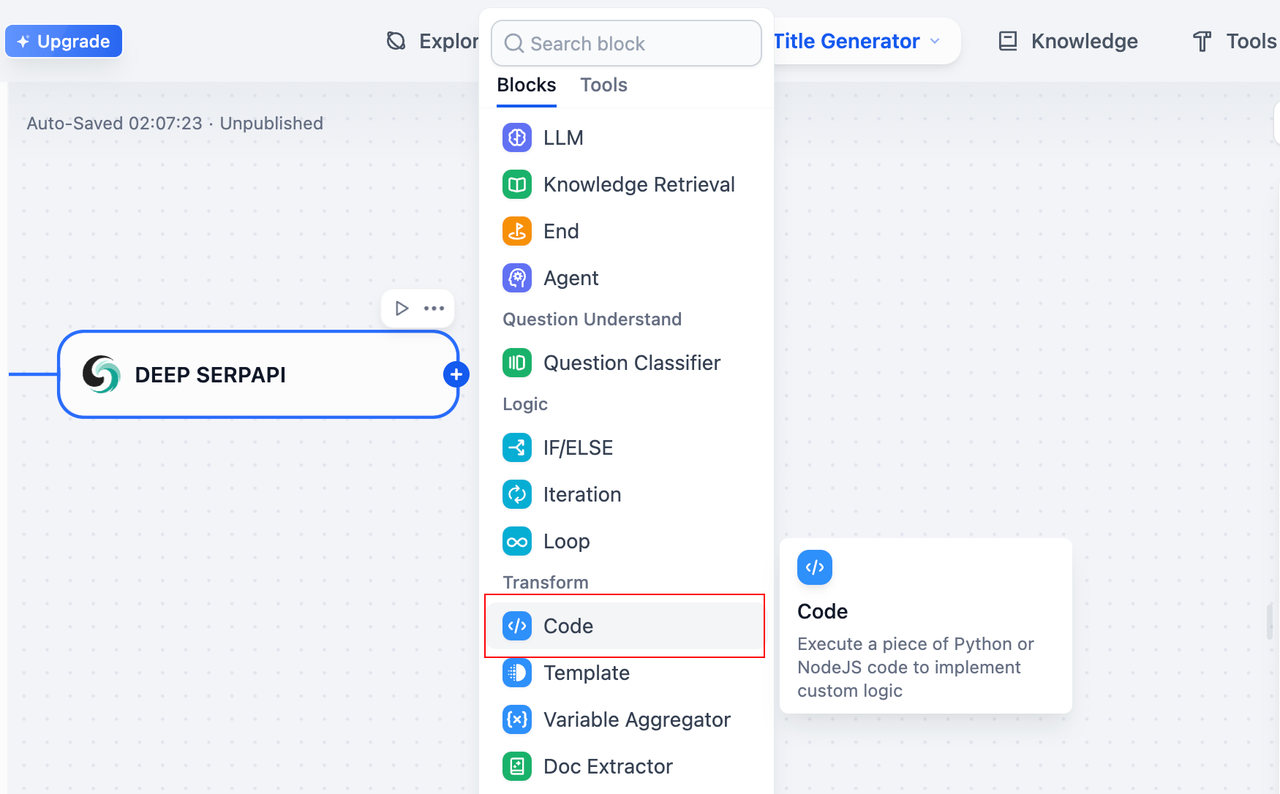
Fill in the following code to convert the JSON structure into a string type for the parameter input of the next node:
JavaScript
function main({result}) {
return {
result: JSON.stringify(result)
}
}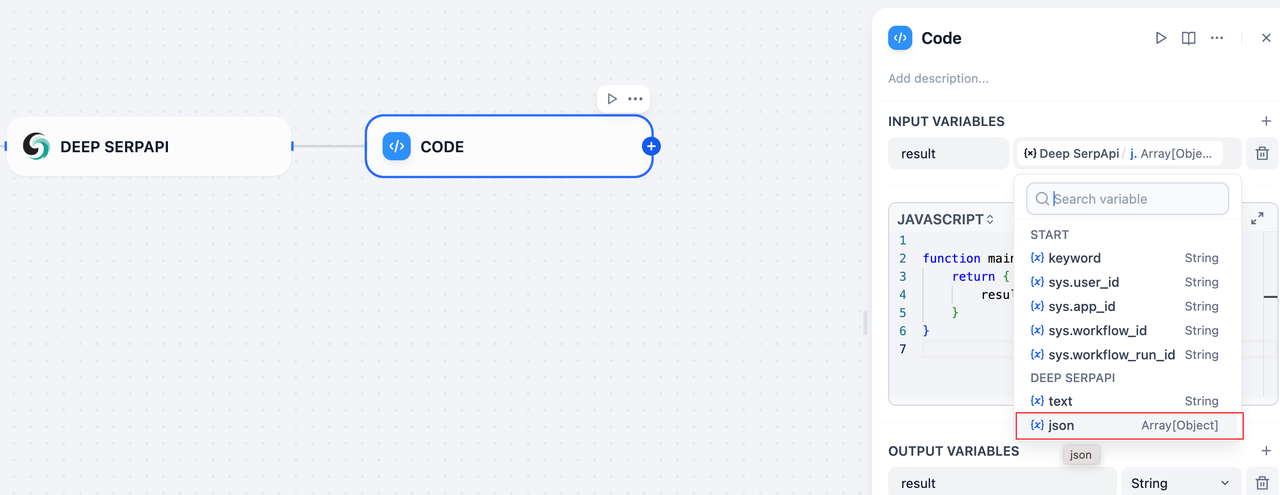
5. Summarize the results and generate blog titles.
Add an LLM node:
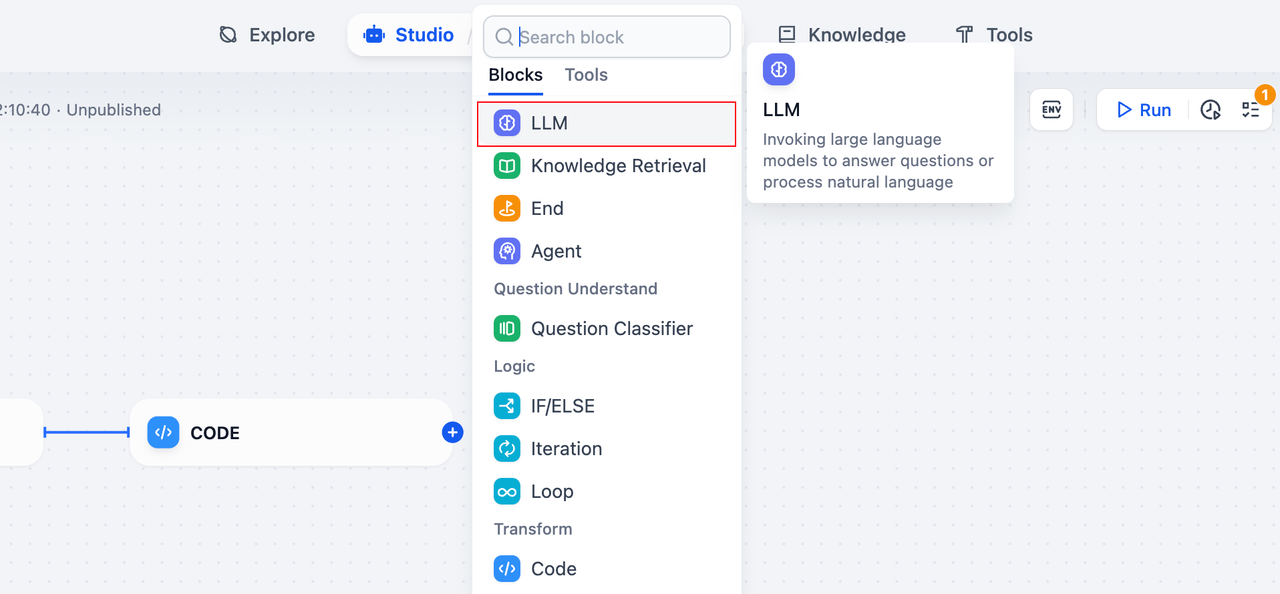
Select the gpt-3.5-turbo model (you can change to other LLM models at will), and fill in the following prompt words. The prompt words will use the search results of Deep SerpApi to generate a more friendly blog title:
PlainText
SYSTEM:
You are an SEO expert and subject-matter expert. Your task is to generate an SEO article title for the keywords provided by the user based on the context of the Google Search.
USER:
For context about what my article should be about, these are the top ranking results for /keyword: /result
What are the principles that made these rank?
ASSISTANT:
To craft an SEO-friendly article title for the keywords "/keyword" that aligns with the principles observed in the top-ranking results you've shared, it's important to understand what made those titles effective. Here are the principles that likely contributed to their high rankings:
1. **Keywords Placement and Clarity**: Each title directly addresses the query by including the exact keywords or a very close variant. This clarity ensures search engines can easily understand the relevance of the content.
2. **Brevity and Directness**: The titles are concise, making them easy to read and understand quickly. They avoid unnecessary words and get straight to the point.
3. **Inclusion of Definitions or Explanations**: The titles suggest that the article will define or explain the concept, which is precisely what someone searching for "/keyword" would be looking for.
4. **Variety in Presentation**: Despite covering similar content, each title approaches the subject from a slightly different angle. This variety can capture interest from a broader audience.
USER:
Given these principles, please help me generate a title that will rank for the keywords "/keyword" by modeling after the syntax of the top ranking titles. Don't copy but give me something better, and avoid language such as "Master", "Comprehensive" or "Discover" or "Unveil". Do not use gerunds, and write in active, present voice only. Return the title only. Do not include any special symbols such as quotation mark and colons. 
6. Add output result node.
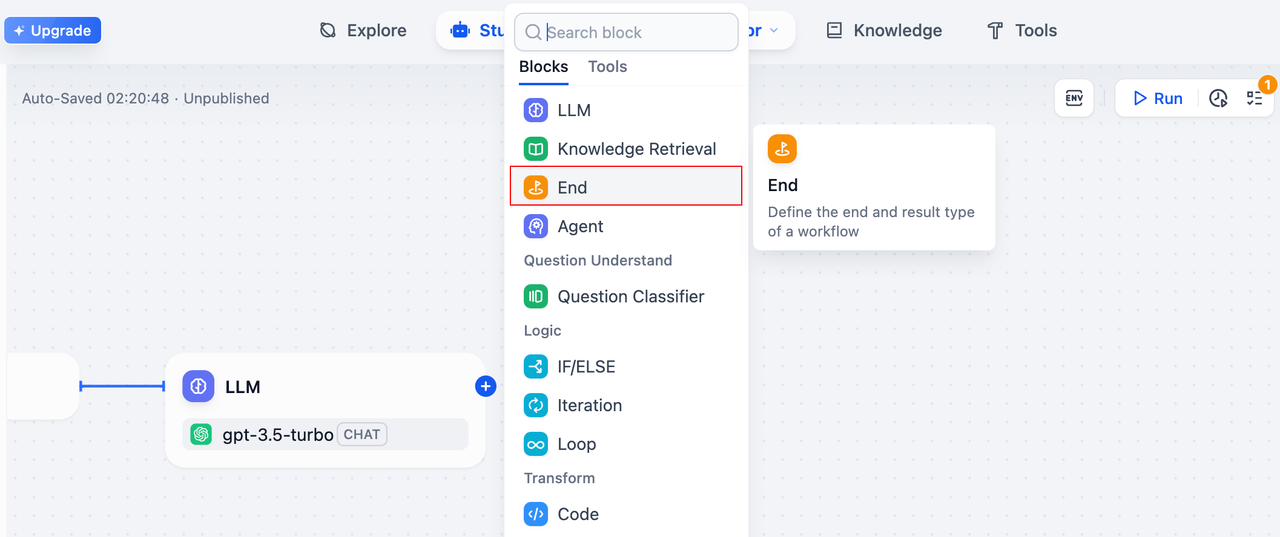

Congratulation! The core process is now complete, next let's test it!
Trial run
Input the keyword "AI content generation" and click "Start Run".

We can see that a blog title with a high Google ranking has been successfully generated.

Release and use
If the above steps are completed, you can confidently proceed with the release.

Once the release is complete, we can use the application:


At this point, you've learned how to build an SEO-friendly blog title generator using Deep SerpApi and Dify!
The Ending Thoughts
With the help of Dify's LLM application framework and Deep SerpApi's powerful data source, we no longer rely on inspiration or manual experience, but build an automated, data-driven, search-intent-compliant title generation system. This not only saves a lot of time for the content team, but also improves SEO results, truly integrating AI into every step of content production.
Start a trial now to explore more possibilities of intelligent tools!
At Scrapeless, we only access publicly available data while strictly complying with applicable laws, regulations, and website privacy policies. The content in this blog is for demonstration purposes only and does not involve any illegal or infringing activities. We make no guarantees and disclaim all liability for the use of information from this blog or third-party links. Before engaging in any scraping activities, consult your legal advisor and review the target website's terms of service or obtain the necessary permissions.
